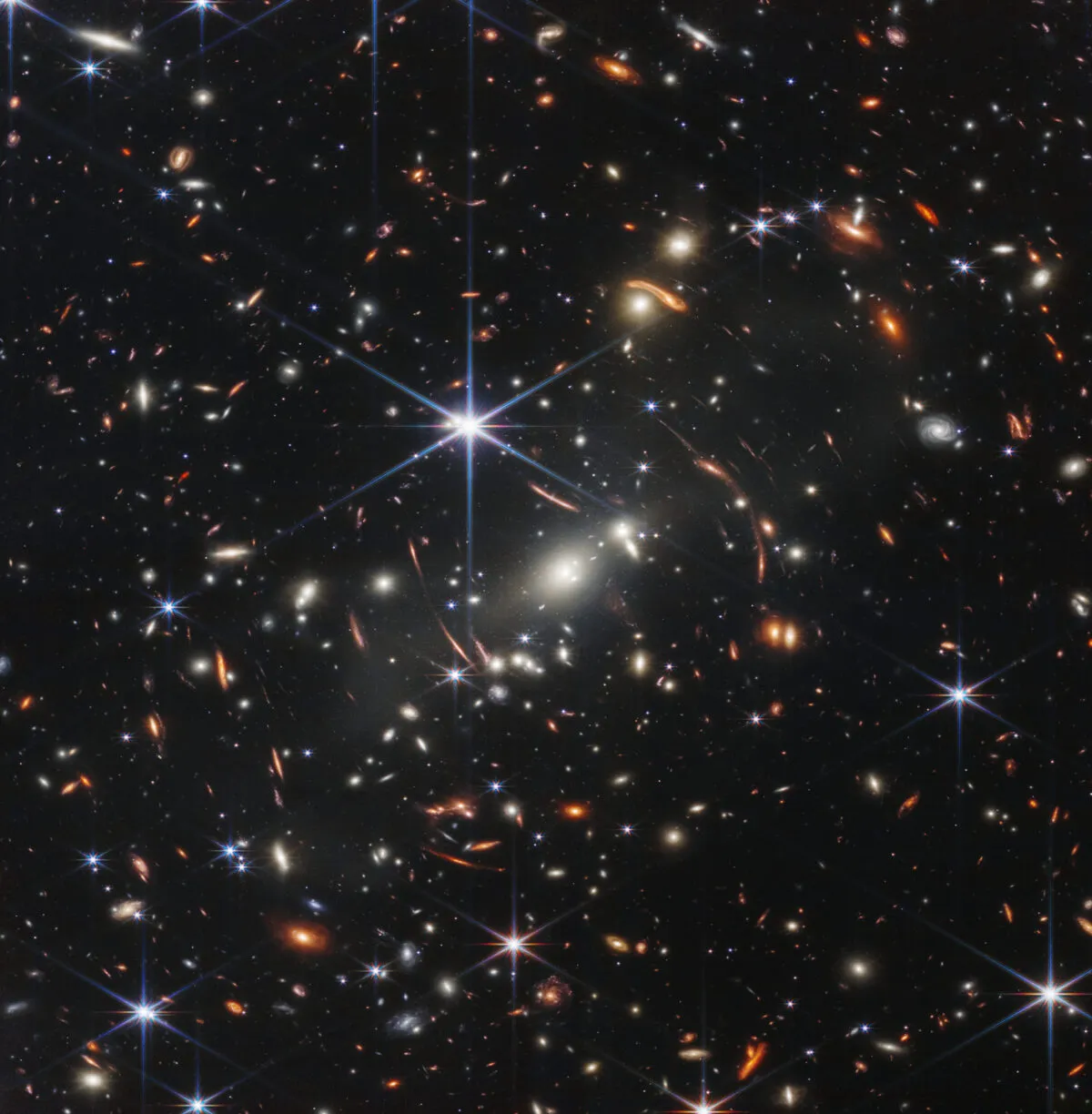Christmas Day 2021 remains a very memorable – albeit stressful – day for me and thousands of my fellow scientists, engineers and technocrats.
After years of delays, the ambitious James Webb Space Telescope finally left Earth.
I, and many others who had worked on the project, watched the launch holding our breath, hoping that nothing would go wrong.
Even after it successfully launched, the nail biting continued for another few weeks as JWST completed its complex unfolding sequence.
But with only a few minor hitches, the telescope was soon ready to take science data.
More amazing Chandra observations

Now, the James Webb Space Telescope is ushering in a new era of astronomy, granting an unprecedented view of the cosmos, observing infrared wavelengths that are invisible to our eyes.
This can cut through dust clouds to see regions where new stars are being born, and travel vast distances allowing us to look back to the Universe’s earliest days.
The James Webb Space Telescope has been snapping phenomenal pictures of our breathtaking Universe for over two years now.
Here are 10 of my favourites taken so far.
Pillars of creation

Nebulae are giant swirls of interstellar gas and dust. Some types of nebulae are called ‘stellar nurseries’ because eddies of gas and dust begin to coalesce, their gravity attracting more matter.
Eventually these clumps collapse in on themselves and stars are born.
One such stellar nursery, the Pillars of Creation, was first brought to the public’s attention when it was photographed by the Hubble Space Telescope in 1995.
To give some idea of scale, the longest pillar on the left projects some four lightyears into space and the small projections on the end are about the size of our whole Solar System.
While Hubble’s view was blocked by the nebula’s dust, JWST’s infrared vision is able to peek through, so we can develop a better understanding of how star formation occurs within these stellar nurseries.
Deep view around SMACS 0723

A number of years ago, I met Robert Williams, who was the director of the Space Telescope Science Institute in Baltimore.
He commissioned the first deep-field observation using Hubble – the Hubble Deep Field (HDF).
In these surveys, the telescope was directed to look at a particular part of the sky for days, rather than the usual minutes.
Many people were shocked when Robert first suggested this idea.
Telescopes like JWST and Hubble are in high demand, yet here was Robert proposing to do a 10-day exposure.
Worse, he and his team were choosing an area of the sky with no known bright objects – a field of view that seemed to be empty space.
The observation went ahead during December 1995 and 342 separate exposures were taken.
The HDF exposures revealed the distance, age and composition of the galaxies imaged.
It was such a success, that JWST recreated the feat, taking this image of galaxy cluster SMACS 0723.
SMACS 0723 zoomed in

There is so much to look at in JWST’s image of SMACS 0723 (Webb’s First Deep Field) that it warrants a closer look.
The galaxies are bound together by gravity, concentrating them in a cluster. Their combined mass can manipulate and bend the light from the galaxies behind them.
This natural phenomenon is called gravitational lensing. The giant object magnifies, distorts and sometimes even creates mirror images of the objects behind it.
There are several mirrored galaxies in this deep-field image – you can see them in the orange stripes that flank the brightest cluster galaxy.
Each galaxy, with its bright, star-filled centre, appears twice in each stripe.
You can see their edges sparkling with stars, like sunlight catching the rim of a wave.
Uranus

Uranus, a massive ice giant, was the first planet to be discovered with a telescope.
It was identified in 1781 by German-British astronomer William Herschel, who initially thought it was a comet or a star.
Uranus takes an incredibly long time to orbit the Sun – 84 years!
That means it will be another 10 years before Uranus completes its third rotation around the Sun since it was discovered.
Its orbit is something that sets it apart from its fellow planets in the Solar System: it appears to rotate on
its side, like a ball rolling around the Sun.
This means each pole gets 42 years of continuous sunshine, followed by 42 years of darkness.
JWST’s NIRCam image of Uranus puts the planet’s north polar cap on display, along with its glowing outer rings.
Exoplanet LHS 475 b

LHS 475 b was the first exoplanet confirmed by JWST. Initially found by NASA’s TESS exoplanet hunter, JWST’s observations go one step further.
It can measure the exoplanet’s transmission – the light that passes through its atmosphere.
In the case of LHS 475 b, astronomers could not detect any gases such as hydrogen or methane.
This led them to deduce that the rocky exoplanet doesn’t have an atmosphere
In the diagram above, the flat yellow line represents the transmission spectrum of an exoplanet with no atmosphere, while the purple line shows what it would look like if it had a carbon-heavy atmosphere, while the green line models a methane-rich atmosphere.
The grey data points of LHS 475 b show that it aligns most closely with the featureless model.
The Ring Nebula

James Webb Space Telescope, 21 August 2023
Credit: ESA/Webb, NASA, CSA, M. Barlow, N. Cox, R. Wesson
The Ring Nebula is an example of a planetary nebula – which, despite the name, have nothing to do with planets.
A few thousand years ago, a star was dying and turning into a red giant; as it did so its outer layers puffed up to many times their original size.
As a star like this expands, its surface temperature drops from around 5,600°C (10,000°F) to 2,000–3,000°C (3,600–5,500°F).
These cooler temperatures cause stars to produce light in the redder part of the spectrum.
Over time, the loosely held gas layers get blown away from the star, creating a spherical cloud of gas, which past astronomers mistook for a planet.
Orion Nebula

The Orion Nebula is a stellar nursery about 2,000 times the mass of our Sun and incredibly bright.
It’s part of the much larger Orion molecular cloud complex.
Stars are forming throughout the complex but tend to concentrate in the Orion Nebula.
JWST’s instruments give us a new perspective on this well-studied object, and not always in ways originally intended.
For instance, it’s easy to see the brightest stars in this image because they have eight prongs due to Webb's famous diffraction spikes.
Collection of PHANGS galaxies

Galaxies are giant systems made up of stars, interstellar gas, dust and dark matter, all held together by gravity.
They’re divided into three main categories: elliptical, spiral and irregular. Elliptical galaxies account for around a third of known galaxies.
They contain little gas and dust, and tend to no longer have active star-forming regions.
Spiral galaxies, such as our own Milky Way, look like the classic flat discs with a bulge in their centres.
These contain actively forming stars and are very common.
Irregular galaxies fall into neither category, and are more common when observing the early Universe.
As part of the Physics at High Angular Resolution in Nearby Galaxies (PHANGS) programme, JWST observed 19 nearby face-on spiral galaxies.
Direct image of exoplanet HIP 65426 b

For a planet, HIP 65426 b is unfathomably large.
It’s known as a ‘super-Jupiter exoplanet’ because it’s between six and 12 times the mass of Jupiter, and it was the first exoplanet JWST observed directly.
In 2022, it was given the official name Najsakopajk, which means ‘Mother Earth’ in the indigenous Mexican language Zoque.
Najsakopajk is of great interest to planetary scientists, because it doesn’t fit our current understanding of planet formation.
It sits very far from its parent star, Matza – just under 100 times further away than Earth is from the Sun.
This separation meant JWST was able to capture the exoplanet’s dim light (Najsakopajk is more than 10,000 times fainter than its host star in the near-infrared and a few thousand times fainter in the mid-infrared) without it being overwhelmed by its parent star.
To do this, JWST used a coronagraph, which effectively blocks out a star’s light so the telescope’s instrument can snap a picture of the planet.
Imaging at a variety of wavelengths reveals different characteristics of the exoplanet – a great showcase of the trailblazing techniques JWST can deploy.
Wolf-Rayet star WR 140

In this image, JWST captured the ripple-like rings of cosmic dust surrounding Wolf–Rayet 140.
We’ve been studying WR 140 for decades, because it’s an incredible example of dust production.
These types of dying stars experience huge mass loss due to their rapid gravitational collapse.
But WR 140 seems to have a particularly high concentration of dust. Scientists aren’t sure whether this is because of the nuclear processes within the star or because it’s not alone.
WR 140 is paired with a massive star, and the two are locked in a cosmic dance around each other.
Every eight years, these two stars are brought together by their orbits.
When they are furthest apart, they are slightly more distant from each other than the Sun and Uranus – just under 3 billion km (1.9 billion miles).
At their closest, they are as near to each other as the Sun is to Earth. The competing stellar winds of the two stars shepherd the dust, creating WR 140’s unique pattern.
What are your favourite James Webb Space Telescope images? Let us know by emailing contactus@skyatnightmagazine.com.
This article appeared in the October 2024 issue of BBC Sky at Night Magazine
